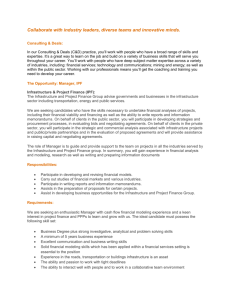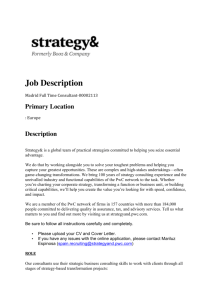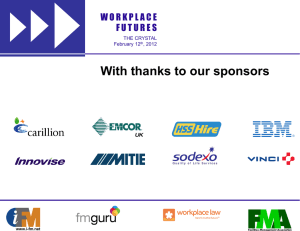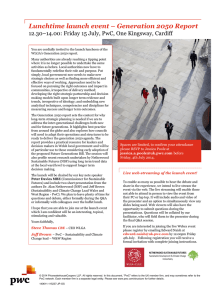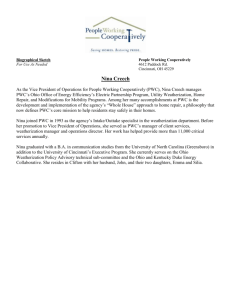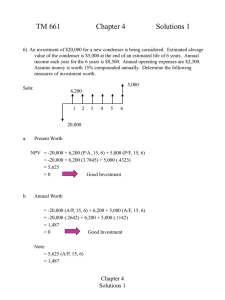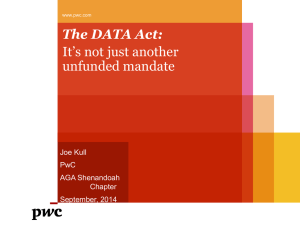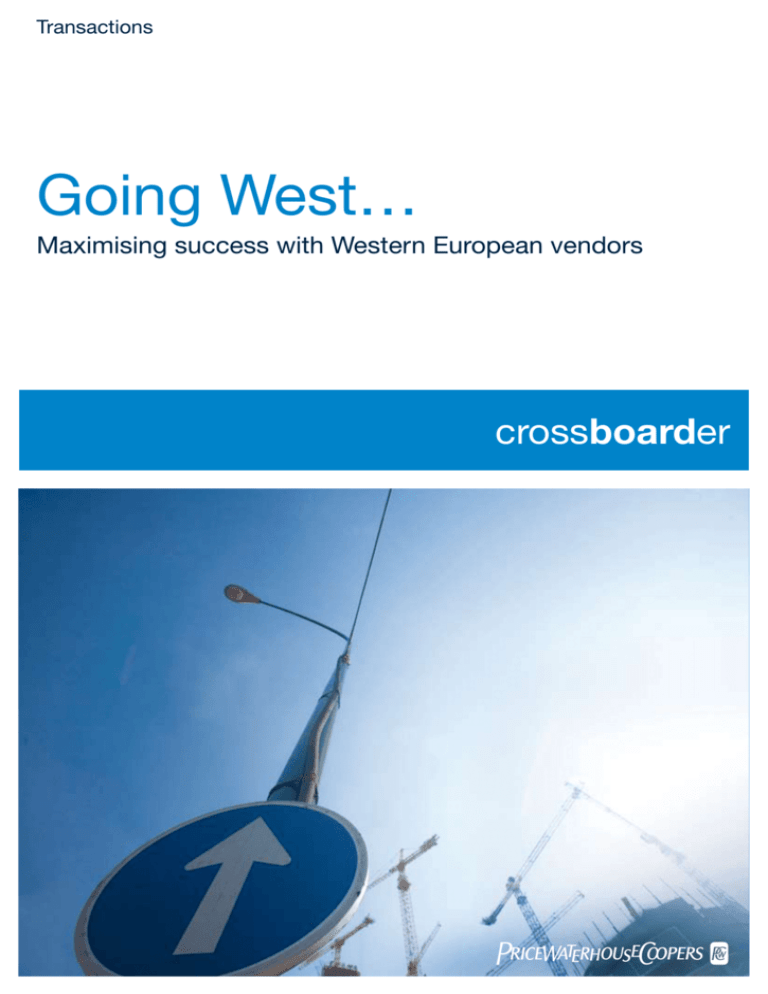
Transactions
Going West…
Maximising success with Western European vendors
crossboarder
pwc
With a burgeoning appetite and increasing competition among
companies and institutions from Emerging Markets (EM) for
acquisitions and alliances in Western Europe, prospective
buyers must ensure that they position and present themselves
in the best possible light when approaching Western European
vendors, in order to obtain access to transactions and
maximise their chances of completing a successful deal.
Destination ‘Western Europe’
Mergers and Acquisition (M&A) activity by Emerging Market1 (EM) entities in Western
Europe has increased dramatically over the last six years. During this period, EM entities
made some 844 acquisitions or investments in the region with a combined value of
nearly €120bn.
As result of the ‘credit crunch’ and the global economic slowdown, 2008 has been a
very weak year for global M&A activity. Despite this, 2008 was a record year for M&A
transactions conducted by EM acquirers or investors, with an unprecedented 256
completed deals.
Whilst we expect the overall slowdown in the global M&A market to continue in
2009, there will be an abundance of attractive transaction opportunities in the
mid-market segment for EM buyers. There are fundamentally strong, under-geared
EM companies that are looking to acquire Western European targets. Having
established themselves domestically as successful enterprises, they will
continue making acquisitions abroad.
There are fundamentally
strong, under-geared
EM entities that are
looking to acquire sound
Western European targets.
Having established
themselves domestically
as successful enterprises,
they will continue making
acquisitions abroad.
The falling valuations of some Western European companies, and the distressed position
of others, could provide imminent acquisition opportunities. While it is important to
tailor your decision-making process in order to respond quickly to such accelerated
opportunities, it is equally important to be selective in your investments or acquisitions
and identify quality companies that will help you meet your long-term strategic goals.
Many Western European vendors can still be reluctant to deal with EM buyers as they
have concerns over their ability to deliver on the transaction. Similarly, some EM buyers
may feel that they are included in a sale process only as an option of last resort, after
the vendors have tried and failed to offer their company to Western European trade and
financial counterparties.
What can EM enterprises do to improve their chances of success? What do you need to
know about doing deals in Western Europe and how can you present your investment
proposition in the best possible light, in order to ensure you are perceived as a credible
and valuable bidder?
Whereas the transaction lifecycle will be broadly similar to dealing with other EM
targets, there are notable differences that will need to be addressed in order to
make the deal work for both parties, especially around bridging cultural differences.
This paper offers some insights on the steps that you might consider taking in order
to bridge these differences and improve your chances of obtaining better access to
relevant opportunities.
Our comments focus on the initial phases of the deal and are by no means exhaustive.
Through our experience of advising on cross-border transactions, we know very well
that every deal is unique and the corresponding challenges are almost always different.
We hope that this document will provide some food for thought and we look forward to
continuing to work with you.
Chris Hemmings
PricewaterhouseCoopers (UK)
Global Corporate Finance Leader
February 2009
1 Emerging Markets are countries or regions with high growth economies, including India, China, Russia, CIS, Latin America and
Central and Eastern Europe.
Going West...
M&A trends and deal drivers
2008 witnessed an
unprecedented 256 deals
where EM buyers acquired
Western European
businesses with an overall
value of more than €45bn.
M&A activity by EM entities acquiring Western European targets has increased over
the last six years, totalling some 844 completed M&A transactions with an overall value
of nearly €120bn. 2008 encompassed a record year with 256 completed deals with an
overall value in excess of €45bn.
M&A Activity 2003-2008
Emerging Market Acquirers / Western European Targets
Equity value (€bn) and number of deals by year
256
50
200
40
150
188
30
151
132
25
100
110
20
Number of deals
Value of deals €bn
35
78
15
61
50
10
5
0
2003
2004
CEE
2005
China
India
2006
Latin America
Middle East
0
2007
2008
Russia / CIS
Number of Deals
Source: Dealogic January 2009
Middle Eastern corporations and sovereign wealth funds (SWFs) have set the pace
accounting for nearly 40% of cumulative transactions by value and 19% by volume
between 2003 and 2008. Chinese private or state-owned enterprises (SOEs) account for
one-fifth of the deals. Indian multinationals looking for technology, brands and routes
to markets have been the most active by volume, performing one-third of the overall
transactions, which account for 18% of the value. Russia’s energy companies and high
net worth entrepreneurs have completed about 15% of the transactions.
M&A Activity 2003-2008
Emerging Market Acquirers / Western European Targets
By target country destination (% of total deals by value)
United Kingdom
57%
France
10%
Switzerland
7%
Germany
6%
Netherlands
6%
Belgium
3%
Spain
3%
1%
Greece
2%
Other
0%
Going West...
36
5%
Italy
1
45
10%
Source: Dealogic January 2009
20%
30%
40%
50%
60%
M&A Activity 2003-2008
Emerging Market Acquirers / Western European Targets
By target country destination (% of total number of deals)
United Kingdom
33%
Germany
45
19%
France
36
10%
8%
Italy
7%
Spain
6%
Netherlands
5%
Switzerland
4%
Austria
3%
Belgium
Other
5%
0%
5%
10%
15%
20%
25%
30%
35%
40%
Source: Dealogic January 2009
We believe that
transactions in 2009 and
beyond will be driven by
fundamentally strong EM
buyers looking for Western
European acquisitions. This
activity will be motivated
by many factors including
market expansion,
backward / forward
integration, knowledge and
technology acquisition,
economies of scale,
access to and association
with international brands
and risk diversification
rationale.
The United Kingdom has been the largest recipient of inbound M&A activity by EM
acquirers in the last six years, accounting for 57% of overall transactions by value and
33% by number. The country’s financial services industry and its openness to and
appetite for dealing with EM investors have been significant deal drivers.
Deal drivers for 2009 and beyond
There will be an overall slowdown in global M&A activity in 2009, as a result of the
reduction in available credit and weak state of the global economy.
It is expected that these conditions will not leave EM entities unaffected, and as a result
some are expected to direct their efforts towards their domestic operations and delay
their overseas investment plans. Some larger Chinese enterprises, for example, are
concentrating on streamlining their domestic operations and will be looking at foreign
acquisitions on a more reactive, rather than proactive, basis. However, some Indian
companies, for example, have continued to make outbound acquisitions in the second
half of 2008, in some cases, competing for assets with other Indian bidders, as in the
case of Axon, where both HCL Technologies and Infosys were keen contenders.
The falling valuations of some Western European companies or the distressed position
of others, will entice some more opportunistic EM enterprises to look for overseas
investments. At the same time, they will be notably more selective in their investments,
and will look beyond the valuations in order to identify fundamentally sound companies.
Transactions that do take place in 2009 and beyond, will be mostly driven by
fundamentally strong EM buyers looking for Western European acquisitions, motivated
by market expansion, backward / forward integration, knowledge and technology
acquisition, economies of scale, access to and association with international brands
and risk diversification rationale.
Going West...
2
Challenges in cross-border transactions
In a survey conducted
by PwC, global CEOs
identified cultural
issues / conflicts as
representing the most
substantial obstacle to
success in cross-border
M&A.
There are numerous challenges that must be addressed in order to make a cross-border
transaction work. In a survey conducted by PwC, global CEOs identified cultural issues
/ conflicts as representing the most substantial obstacle in cross-border M&A.
Key obstacles for cross-border M&A
Cultural issues/
conflicts
54
Unexpected costs
45
Realising the expected value
of the transaction
Poor management of
human resources
40
40
Conflicting workforce
expectations
Conflicting regulatory
requirements
Assessing the tax
implications
Accessing finance at the
right price
32
31
21
21
Stakeholder opposition
18
Trade barriers and
protectionism
14
0
10
20
30
40
50
60
Source: PwC Global CEO Survey 2009
It is important to note that these issues are not unique to EM acquirers, and these types
of challenges are prevalent in all cross-border transactions. However, Western European
vendors often have concerns about the ability of EM buyers to deliver on their side of
the deal; such concerns must be allayed if a deal is to complete successfully.
The remainder of this document provides some insights on the steps that an EM
acquirer should consider in order to be perceived as a credible bidder to obtain access
to Western European deals and maximise their chances of completing successful crossborder transactions.
3
Going West...
Tailoring your acquisition strategy
towards Western European vendors
Typical Western European Acquisition Process
Develop acquisition strategy
Sector outlook
Country / sector
opportunities
Long list of
potential targets
Short list
potential targets
Target evaluation
Making the
offer
Negotiation/
completion
Determine
ownership structure
Detailed valuation
Heads of
agreement/SPA
Evaluate likelihood
to sell
Raise finance
Negotiation
Initial
meetings
Make indicative
offer
Confirmatory
due diligence
Confidentiality
agreements
Negotiation
strategy
Regulatory
compliance
Additional
information
Deal completion
Identify possible
areas of weakness
Develop
investment story
Additional
information
Site visits
Due diligence
Post-deal
integration
Final offer
Identify target companies in Western Europe
The process of identifying possible target companies in Western Europe is similar to
the one you would normally conduct in your domestic market – you could either perform
a ‘top-down’ analysis and filter the companies yourself, or you could use advisors
who would be able to inform you quickly about specific opportunities and potentially
attractive targets.
In a ‘top-down’ approach, one question to bear in mind from the outset is whether the
sector is considered to be of ‘strategic importance’ in that particular target country and
hence protected from acquisitions by foreign companies. From a Western European
perspective, the concern is that EM investments, particularly by SOEs and SWFs, may
be motivated by political (as well as economic) rationale. This will mean that foreign
buyers will need to seek government approvals when considering acquisitions in those
sectors, which can be time-consuming and difficult to obtain.
Such pre- or mis-conceptions can prevent Western European vendors from approaching
relevant EM acquirers and giving them the opportunity to bid for their assets.
Going West...
4
You will need to perform
a critical analysis of your
own organisation.
Identify possible areas of strength and weakness in your
company
Reflecting attention back to your own entity, you will need to perform a critical analysis
of your organisation, focussing on some key questions:
Do you already have a track record in domestic and international M&A activity?
Have you previously made acquisitions in Western Europe? Previous experience will be
an advantage. You will need to be prepared to share information on transactions that
you have already completed, including the firms that have provided financial and legal
advice. This will help in building credibility, and will demonstrate your serious interest
in the sale process. You might also share the names of the CEOs or CFOs of the target
companies that you have acquired, so that the vendor can speak to them and obtain
references.
Do you have access to acquisition finance?
Do you plan to finance the purchase with cash, debt or equity in your business? Do
you have access to acquisition finance and where does this finance come from? You
should be prepared to discuss these aspects openly in order to help build trust with the
vendor, especially if a third party financier / equity investor is involved and they have a
significant role in your decision making process.
Do you understand Western European sell-side processes?
If not, use experienced global advisors to help you understand Western European deal
processes. Ensure you appreciate the timeline, what legal documents are required
when, which parties should be involved, and what deliverables are needed at each
stage of the process.
Do you have ‘clean’ audited financial statements?
The quality of financial reporting in some EM countries can be inconsistent with Western
European standards. To allow the vendor to gain confidence about your financial strength,
EM buyers need to be able to show their target a robust set of audited accounts, which
are as transparent and as comparable as possible to Western European standards, and
ideally prepared under IFRS or the local Western European GAAP.
How robust is your entity’s corporate governance structure?
EM acquirers must be aware that corporate governance is an immensely important
issue throughout Western Europe. Market regulators and vendors will need to be
reassured that an incoming buyer is aware of their responsibilities and liabilities in
this regard, and that they have a clear action plan to implement a sound corporate
governance structure post-acquisition.
How well do you understand the target’s local regulatory and legal requirements?
Demonstrating a clear understanding of the target country’s regulatory and legal system
will present you as a serious and sophisticated suitor, particularly if you are expected to
deal with international stock exchanges or any other overseas market regulators. You
will need to develop an understanding of these requirements before embarking on an
acquisition in Western Europe.
Other key areas include anti-trust and environmental regulations. In most EMs, these
regulations are either not common, or are in their infancy, and accordingly some EM
acquirers may not be very familiar with them. Experienced and knowledgeable advisers
can assist you in understanding the relevant issues.
5
Going West...
Develop a compelling investment ‘story’
Having performed detailed analysis of the target entity, and having reflected on your
own company, you need to spend some time considering your investment ‘story’. Put
yourself in the shoes of the Western European vendor to try to understand what is
important for them and what their viewpoint might be on a possible foreign purchaser.
Focus on key points relevant to the vendor and leverage your strengths in order to
create your investment story, presenting the deal as a positive strategic step for the
Western European target, and illustrating that the acquisition will have a transformational
and beneficial effect.
Vendor concerns
Put yourself in the
shoes of the Western
European vendor to try
to understand what is
important for them and
what their viewpoint might
be on a possible foreign
purchaser.
Some Western European vendors might feel that they are ‘losing face’ within their local
community by selling to an EM buyer. This can be a particular concern for family-owned
businesses where local stakeholders may perceive such a sale as the last resort for
a business in financial distress. Others may be concerned that the EM acquirers are
simply looking to buy a particular technology to take back to their home market, which
will lead to discontinued European production and local redundancies.
Your investment story needs to be very clear regarding your future strategy with the
target, and why in your view the acquisition makes strategic sense.
Long term investment
As a result of the credit crunch and stagnating economic prospects, many Western
European companies may be struggling to meet the terms of loan covenants or to
pay the interest on issued debt. Consequently, they may be facing administration or
receivership procedures and could be deemed to be ‘distressed’. For some EM buyers,
the acquisition of a Western European company might have a significant strategic
value, and in the recent past EM bidders have demonstrated that they are prepared to
look beyond short-term financial issues and high levels of gearing when contemplating
acquisitions to develop a compelling long-term investment proposition.
Exposure to high-growth markets
A declining market in Western Europe may well translate to a growth market in an
emerging economy. Consider whether the products of the target company can be sold
in your domestic market under the same brand via your distribution network – increasing
their global reach. If you think that it will be viable for the local name or brand to remain
the same post-acquisition, developing your investment story around such a premise
could be a successful strategy.
Redundancies
Consider whether there will be many local redundancies as a result of your acquisition.
If your rationale is to acquire a launch pad for entry into the Western European
market, this might play in your favour relative to other local bidders. If you do not
have an existing hub in Western Europe, the prospect of cost synergies through office
consolidation and redundancies is lower compared to other potential Western European
trade bidders, whose investment case might be based around such synergies and which
would be likely to lead to more job losses at the target entity.
Going West...
6
Unless you have a
Approaching the target
previous relationship with
Who are the decision-makers?
the vendor, it is helpful
When you start short-listing the possible targets and identifying the key decision
to work with an advisor
makers, you will find that in some Western European countries it is not difficult to
identify key shareholders and executives from public sources or proprietary databases,
who has an existing
given the transparent and rigorous nature of local financial reporting and accounts filing
relationship with or access requirements.
to the vendor, so that
In other countries, this can be a more complicated process. Whereas contacting the
Head of M&A might be a good start for some larger quoted companies, contacting the
they can introduce key
owner-manager directly might be more relevant for mid-sized targets, but this can be
management and other
difficult to achieve without an introduction from a trusted advisor.
relevant decision makers. Making the first move
Unless you have a previous relationship with the vendor, it is helpful to work with an
advisor who has access to the vendor and can provide you with an introduction to their
key management, and other relevant decision-makers. Such advisors are likely to have
a direct relationship with the target company, understand the local market dynamics,
and work for you to facilitate the initial communication. Furthermore, Western European
vendors are accustomed to doing deals via intermediary advisors.
At the same time, it is important to involve the real decision-makers in your company
at this initial stage (and subsequent key points in the deal), rather than working solely
through advisors, in order to build a strong and effective relationship with the target.
The objective of this phase is to establish rapport with the key decision-makers at
the vendor, convey that you are a credible counterparty and achieve a positive initial
response from them. This response will be influenced by the language in which you
make the first contact; if you do it in the local language of the vendor, you are more likely
to achieve an encouraging answer.
The vendor management’s initial reaction could be guarded, as it takes time to build
trust and they will be keen to understand your deal rationale, integration plans and
ability to finance the deal. As the relationship evolves, the approach could become more
informal. From the outset, you will need to work hard to convey your investment story
and describe precisely who you are, what your business does, why you wish to make
the acquisition and what you plan to do with it post-acquisition. To this end it will help
if you demonstrate a clear understanding of the target country’s political and regulatory
system and the local corporate governance requirements.
Communicate clearly how the decision-making process works within your organisation
and give an indication of the timeline within which you would be able to complete the
deal, at the same time expressing a willingness to be flexible and adapt to the seller’s
timetable.
7
Going West...
Continuing the conversation
Once a dialogue has started with a target company it is important to keep the
momentum going. This means that your internal decision-making processes need
to meet the deadlines agreed with the target. If not, you will quickly find yourself in a
competitive auction process.
It is highly likely that you will be required to sign confidentiality letters or non-disclosure
agreements before being given access to business-sensitive information. Use this stage
to obtain the relevant information that you need to form your views on an indicative
offer. At the same time, be aware that some vendors may not wish to disclose details
which could be useful to potential competitors if the deal does not complete.
Your internal decisionmaking processes need
to meet the deadlines
agreed with the target. If
not, you will quickly find
yourself in a competitive
auction process.
Be prepared for the fact that Western European vendors place more emphasis on cash
flow and EBITDA multiples, so the format of the information supplied to you is likely to
be focused on these key metrics. While this type of information is acceptable to many
EM acquirers, if this is different from your focus areas, such as net assets or intellectual
property, be specific about the additional information requirements at an early stage.
At the same time, the vendor will want to know as much as possible about your
company. Be open about your ownership and financial backing and set out the
expectations and objectives for the acquisition itself. Offering to provide your audited
financial statements and speaking about your track record in M&A activity will reflect
well upon you. In some instances, particularly in respect of merger share swaps and
joint venture activities, the vendor may request reverse desk-top due diligence.
Competitive auction process
The focus of this paper is on pre-emptive deal processes which exclude
the prospect of other possible bidders. In reality, expressing your
interest in purchasing the target may well trigger an auction process.
Alternatively you might have heard about a pre-existing auction process
from your financial advisors and wish to join in.
Many EM acquirers, in particular those from India and China, are used
to prolonged sales processes involving extended periods of exclusivity
driven by their consensus-based decision making. As a consequence,
auction sales, which take place in a short and frenzied period of time,
have not generally been attractive to EM buyers. Lack of time and limited
experience in Western European M&A, have meant that in some cases
EM buyers have been unable to make the quick strategic decisions
required to meet the tight deadlines in a typical Western deal process.
Thorough preparation on your part is vital, so that if necessary, you
are able to increase the speed of your response to the vendor, making
them comfortable with your ability to deliver the deal. Dedicating senior
resource with a mandate to make prompt decisions will afford you the
chance to compete on a par with more experienced Western rivals.
Going West...
8
Timing is a critical factor
at this stage... the vendor
will be sensitive to the
speed with which the deal
can be closed.
Making the offer
Managing and meeting expectations
The quality of the indicative offer document is extremely important in Western Europe.
The standard will convey the professionalism and credibility of the would-be acquirer.
Typical features that are expected to be included in the indicative offer are: a clear
description of the consideration for the deal and any price adjustment mechanisms;
the proposed financing and debt structure; management and employee incentivisation
if appropriate; the future strategy of the combined business; deal timetable; key
commercial assumptions; and, should the process allow it, second stage / confirmatory
/ closing due diligence requests.
Sometimes this indicative letter will be converted into non-binding Heads of Terms
which is then used as the basis for preparing the binding legal documents by the
lawyers. On other occasions, the deal will move directly to legal documents from the
offer letter. We strongly recommend that EM buyers request that a Heads of Terms be
agreed, as it will greatly reduce the potential for misunderstandings at a later stage
of the deal. It is also critical that any conditions precedent to the deal and essential
representations / warranties are specified at an appropriate time.
Timing is vital
The proposed deal timetable could present more of a challenge to an EM acquirer
than a Western European trade or financial buyer. Whereas the latter typically asks for
a 4-6 week exclusivity period after acceptance of the indicative offer, EM acquirers
sometimes expect much longer periods.
Be aware that timing is a critical factor at this stage, as the vendor will be sensitive to
the speed with which the deal can be closed, and counter-bidders may well be waiting
to approach. It is advisable to reduce the exclusivity period to minimum levels in order
to keep the momentum of the deal going.
Regulatory compliance
EM acquirers must acknowledge the importance of compliance with local laws,
regulations and expected codes of conduct. Western European economies are highly
regulated and the rules are more stringent when the target is a listed business.
When targeting listed businesses in the United Kingdom, for example, EM acquirers will
need to comply with the Takeover Code whilst executing the deal, in addition to laws
and regulations on health and safety, environmental liabilities, employment law and
corporate governance when running the business.
9
Going West...
Section Titlethoughts
Concluding
With the combined effects of the credit crunch curtailing other
forms of M&A activity and the seemingly irresistible movement of
global economic gravity towards Emerging Markets, EM entities
are rapidly gaining experience in doing deals in Western Europe.
However, Western European vendors still have concerns as to whether EM acquirers are
credible and able to deliver deals on a timely basis, thus sometimes only approaching
them as a last resort.
By preparing carefully before you approach the target, analysing and addressing your
own strengths and weaknesses, developing and delivering a compelling investment
story, being open and transparent about your entity and your future strategy, and getting
the communication and timelines right, you stand a much higher chance of being
perceived as a credible M&A bidder, and you will be better positioned to close the deal.
Appointing experienced deal advisors will assist you not only to manage the financial
and operational elements of the transaction, but will provide you with a mechanism with
which to bridge any cultural gaps, maximising your chances of success.
PwC has been successfully advising on cross-border deals for many years. We
know that each deal has unique requirements with corresponding opportunities and
challenges, and our experience and our people can help guide you through each stage
of the deal cycle to a fruitful conclusion.
PwC experience in cross-border transactions
• Over the last 10 years, PwC advised on more than 3,200 deals
globally, of which 39% were cross-border
• During the last five years, we advised on 100 Emerging Market
transactions, with a combined deal value of $12.2bn
• In 2008 alone, PwC advised on 82 European cross-border deals with
a combined deal value of $8.1bn
10
Key contacts
Global Corporate Finance Leader
Chris Hemmings
+44 20 7804 5703
chris.hemmings@uk.pwc.com
China
UK
Xie Tao
Neil Sutton
+86 10 6533 2002
tao.xie@cn.pwc.com
+44 20 7213 1074
neil.sutton@uk.pwc.com
India
Germany
Bharti Gupta Ramola
Werner Suhl
+91 124 4620503
bharti.gupta.ramola@in.pwc.com
+49 69 9585 5650
werner.suhl@de.pwc.com
Middle East
France
Nitin Khanna
Noel Albertus
+971 4 304 3200
khanna.nitin@ae.pwc.com
+33 6 07 43 66 81
noel.albertus@fr.pwc.com
Russia / CIS
Benelux
Michael Knoll
Andries Mak van Waay
+7 495 967 6058
michael.knoll@ru.pwc.com
+31 20 568 6509
andries.mak.van.waay@nl.pwc.com
CEE
Switzerland
Chris Butters
Philipp Hofstetter
+420 251 151 203
chris.butters@cz.pwc.com
+41 0 58 792 1506
philipp.hofstetter@ch.pwc.com
Latin America
Canada
Jorge Bacher
Keith Mosley
+5411 4850 6814
jorge.c.bacher@ar.pwc.com
+1 416 941 8307
keith.mosley@ca.pwc.com
Southern Africa
Australasia
Simon Venables
Tom Fenton
simon.venables@za.pwc.com
+27 11 797 5660
+61 2 8266 2759
tom.fenton@au.com.com
Japan
USA
Matthew Wyborn
matthew.j.wyborn@jp.pwc.com
+81 3 6266 5740
For US residents requiring information on
corporate finance related services, please contact
our registered FINRA Broker Dealer within the
US, PricewaterhouseCoopers Corporate Advisory
and Restructuring LLC, which can be contacted
directly at:
Michael Milani
+1 312 298 2755
michael.milani@us.pwc.com
11
Going West...
About PricewaterhouseCoopers
The member firms of the PricewaterhouseCoopers (PwC) network provide
industry-focused assurance, tax and advisory services to build public trust
and enhance value for its clients and their stakeholders. More than 155,000
people in 153 countries across our network share their thinking, experience and
solutions to develop fresh perspectives and practical advice.
About Crossboarder
Crossboarder is a series of briefings for the Board on the opportunities and
challenges presented by high growth economies.
Important notice for US residents: In the US, corporate finance services are provided by PricewaterhouseCoopers Corporate Advisory and
Restructuring LLC, a member of the FINRA and SIPC. PricewaterhouseCoopers Corporate Finance and Restructuring is not engaged in the practice
of public accountancy.
This publication has been prepared for general guidance on matters of interest only, and does not constitute professional advice. You should
not act upon the information contained in this publication without obtaining specific professional advice. No representation or warranty (express
or implied) is given as to the accuracy or completeness of the information contained in this publication, and, to the extent permitted by law,
PricewaterhouseCoopers does not accept or assume any liability, responsibility or duty of care for any consequences of you or anyone else acting,
or refraining to act, in reliance on the information contained in this publication or for any decision based on it.
pwc.com
© 2009 PricewaterhouseCoopers. All rights reserved. ‘PricewaterhouseCoopers’ refers to the network of member firms of PricewaterhouseCoopers
International Limited, each of which is a separate and independent legal entity.
Design: hb03944

